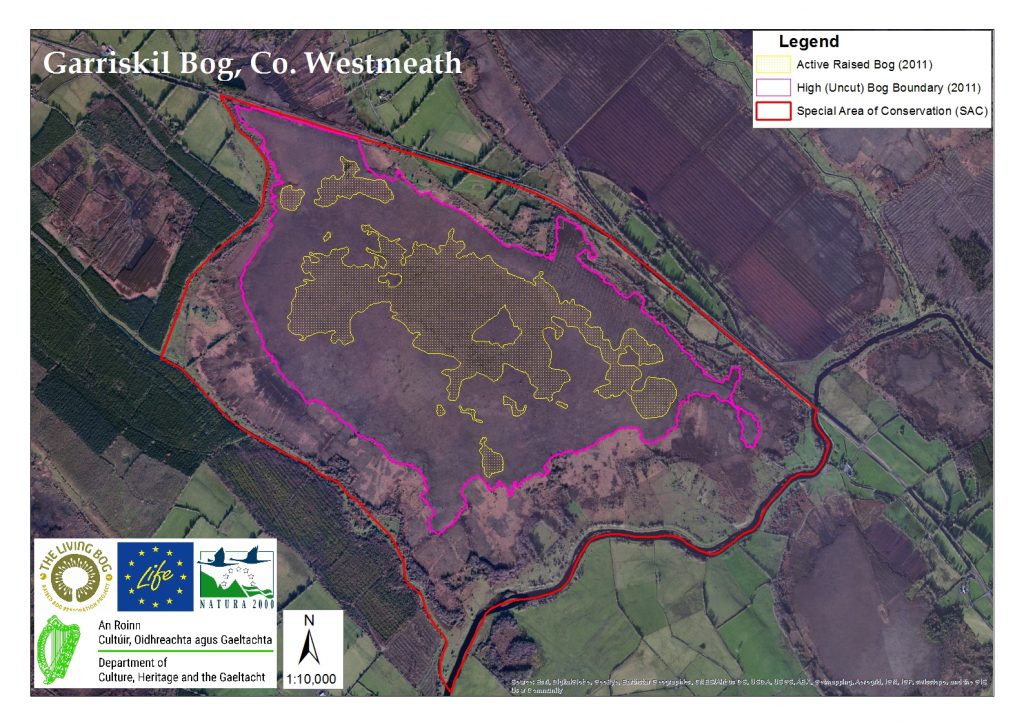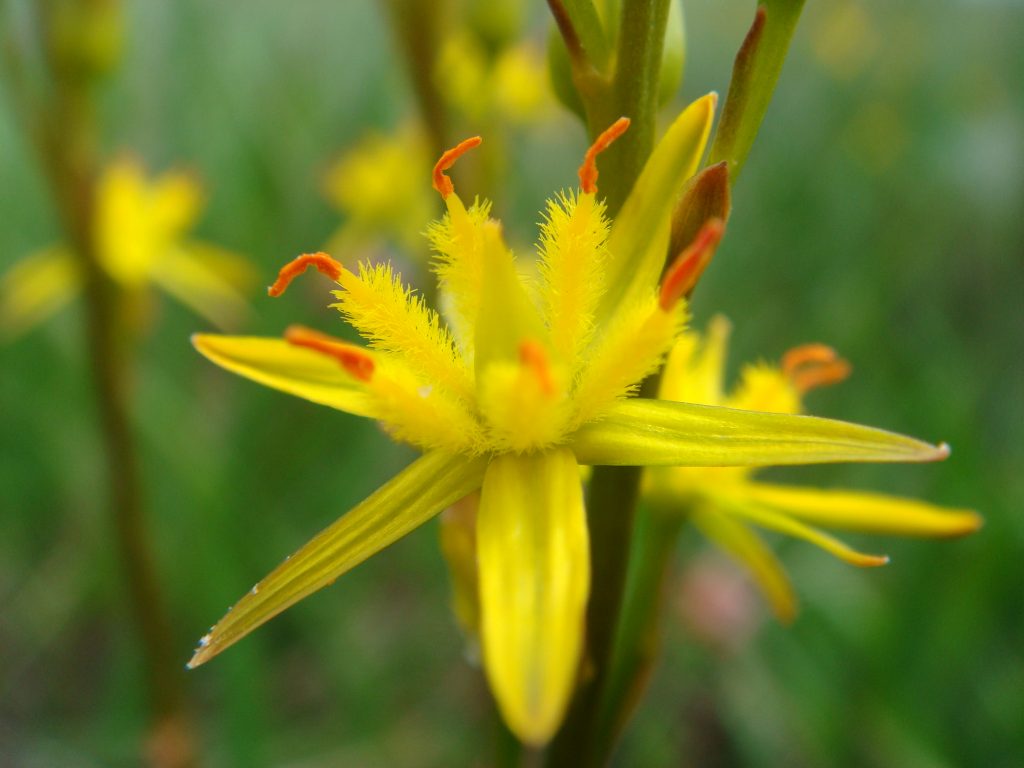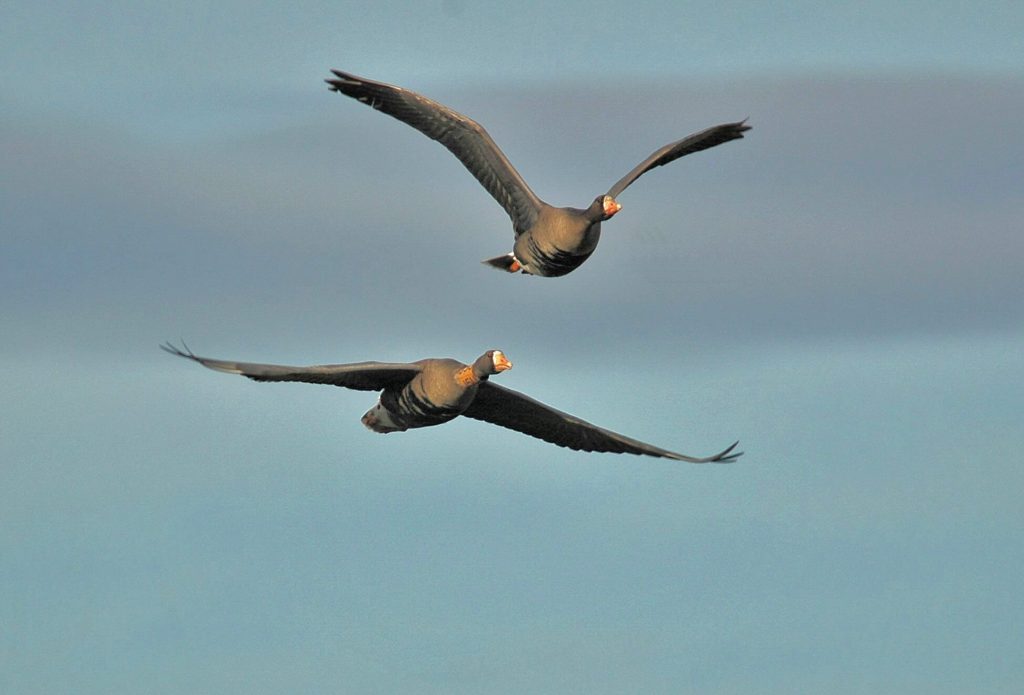Life On Garriskil Bog
Garriskil Bog is a large raised bog with 51.7% of the original bog still present. It contains a large, wet high quality central core of active raised bog which comprises approximately 51 ha (30%) of the uncut high bog area. There are extensive, well developed systems of pools and hummocks present. It is a good wet bog with plenty of life.

Past drainage of the bog, associated with arterial drainage of the Inny and Riffey rivers and peat cutting, has unfavourably impacted on the site and led to widespread subsidence and drying out. The northern area of the site was also affected in the 1990s by intensive surface drainage which directly affected the area of ARB reducing it from 71 ha to 45 ha. Those drains were blocked by NPWS in the late 1990s and by 2014 the area of ARB had increased by 5.5 ha to 50.9 ha. There has been no turf cutting since the 1990s and though burning has caused damage in the past, there has been no severe fire in recent years.
FLORA OF GARRISKIL

Bog Asphodel
The bog mosses Sphagnum imbricatum, S. fuscum and the moss Leucobryum glaucum are important components of the hummocks, which are frequently crowned by the moss Racomitrium lanuginosum and sometimes colonised by Bilberry (Vaccinium myrtillus). The numerous areas of inter-connecting pools are mostly dominated by Rhynchosporion vegetation which forms floating rafts on the water surface. Typical plant species present include the bog mosses Sphagnum cuspidatum (generally dominant) and S. auriculatum, the liverwort Cladopodiella fluitans, White Beak-sedge, Bogbean (Menyanthes trifoliata), bladderworts (Utricularia spp.), Common Cottongrass (Eriophorum angustifolium) and Great Sundew (Drosera anglica). Brown Beak-sedge, a sedge species considered to be rare on a national basis, is present in some of the bog pools. The areas between the pools support occasional wet and quaking lawns of White Beak-sedge, as well as Bog Asphodel.
The vegetation of the rest of the high bog, including the DRB, tends to be dominated by Heather (Calluna vulgaris), Deergrass, Bog Asphodel, cottongrasses (Eriophorum vaginatum and E. angustifolium) and Cross-leaved Heath (Erica tetralix). The distribution and relative abundance of these species varies with peat wetness. Sphagnum cover is generally less than 30%. In these drier areas the cover of the lichen Cladonia portentosa can be locally high. Outside the ARB area, pool complexes are rare and where they do occur they tend to be dominated by shallow open water or algal mats. Small areas of Rhynchosporion vegetation also occur here, however the habitat is, in general, not well developed outside the ARB area. In a number of places the high bog is being invaded by Downy Birch (Betula pubescens) and pines. Often the pines are associated with small flushes dominated by species such as Purple Moor-grass (Molinia caerulea), Soft Rush (Juncus effusus), Bramble (Rubus fruticosus agg.) and Heather.
The large areas of old cutover bog provides an additional habitat where Purple Moor-grass and Heather dominate, along with cottongrasses, while in some parts Downy Birch woodland is developing. Along the north-east margin of the high bog a narrow band of fen-grassland occurs.
A relatively scarce lichen, Cladonia rangiferina, is found in abundance on and around hummocks in the ARB on the site (Douglas & Grogan 1986).
On a negative note, invasive species Pinus sylvestris and Rhododendron ponticum are found in several locations on the high bog.
FAUNA OF GARRISKIL

Great white fronted geese on the wing
The LIFE team are currently surveying the site and their fauna observations will appear here soon.
The following is based on information contained in NPWS in 2004: A flock of Greenland white-fronted geese (Anser albifrons flavirostris) (listed in Annex I of the Birds Directive) ranges over the midland lakes, including those close to the site (e.g. Lough Derravaragh). In the winter of 1993/94 this internationally important flock consisted of 346 birds (Fox et al. 1994). Garriskil Bog formerly provided an important feeding and/or refuge area for the geese, but Fox et al. (1994) report that the birds now feed mostly on intensively managed grassland and take refuge on the lakes. With rewetting it is hoped to entice the birds back to the bog.
A pair of breeding Merlin (Falco columbarius) (Annex I, Birds Directive) have been reported to hunt within the site and breed in a nearby conifer plantation. These are of high conservation importance.
Other birds using the site include hunting barn owl (Tyto alba) and small numbers of breeding redshank (Tringa totanus), curlew (Numenius arquata), lapwing (Vanellus vanellus) and snipe (Gallinago gallinago), with meadow pipit (Anthus pratensis) also occurring during the summer months.

